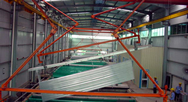 |
|---|

|
||||||||||
|
|---|
ANODISING
Aluminium's ability to respond to anodising makes it an important metal. The fact that Aluminium can be made in attractive, durable and tough finish makes it adaptable to a wide range of applications from partitions to vehicle components. Anodising is a conversion of the metal ,which creates a protective inert film of Aluminium oxide. This film will not crack, peel, or chip unless subject to severe stress or extreme thermal changes
The Anodising process is Electro-chemical in which the natural oxide film is created by passing an electric current through dilute Sulphuric Acid with the Aluminium part as the anode. The anodised film created is microscopically porous, which needs "sealing" in either boiling water with a simple soap addition or some of the newer seal additives.
The full process usually involves a chemical pre-clean, followed by immersing the products in a chemical to give the required finish. Phosphoric Acid solutions giving a bright finish and a caustic soda based solution, giving a matt appearance.
Anodising also provides a means of colouring the oxidised metal. Anodic films are coloured by a variety of methods. Pigments and organic or inorganic dyes are dissolved in heated water and the products immersed prior to sealing while they are still porous. The colour is then sealed in place by the usual method. The more durable coloured films necessary in exposed environments can be produced as part of the anodic layer and are quite permanent.
The thickness of the Aluminium oxide coating can be varied by processing time. The following figures are usual.
· 5 Micron
is suitable for decorative applications
· 10 Micron
is suitable for internal applications, and outdoor applications where cleaning is very frequent, for example, caravan trim.
· 15 Micron
is recommended for the majority of ordinary architectural requirements.
· 25 Micron
is recommended for heavy duty external permanent architectural applications where little deterioration can be tolerated.
· 25 Micron plus is achieved by Hard Anodising this is done by varying the electrolyte composition and modulating the process parameters. Hard anodic films are used to provide abrasion resistant surfaces on bearings, pistons, gears, and other components.

Vertical line

Horizontal line
© Copyright 2008 D.I.V.A World Trade Co. Limited. All Rights Reserved
 Corporate Profile
Corporate Profile